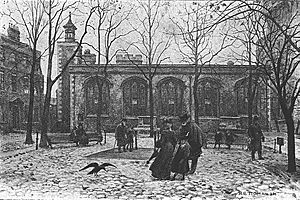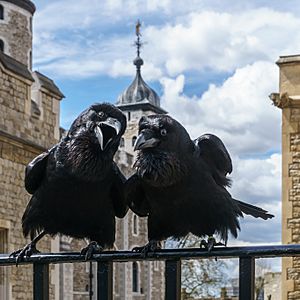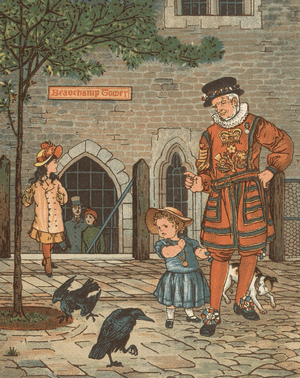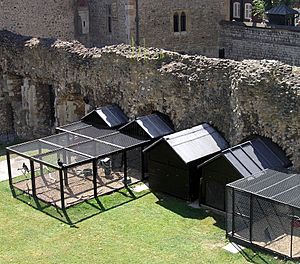Ravens of the Tower of London facts for kids
The Tower of London is home to at least six special ravens. People traditionally believe these ravens protect the British Crown and the Tower itself. There's an old story that says if the ravens ever leave, the Crown will fall, and Britain will too! However, some historians, including the Tower's official historian, think this story about the ravens is a fun tale from the Victorian era (the late 1800s). The first known picture showing ravens at the Tower is from 1883.
Long ago, wild ravens lived all over Britain, even in cities like London. The Tower was a natural home for them. But as time passed, ravens disappeared from most of Britain. Now, the ravens at the Tower can only live there because they are kept safe and cared for. The Tower ravens are looked after by a special person called the Ravenmaster, who is part of the Yeomen Warders (also known as Beefeaters). A local legend says that keeping ravens at the Tower started with King Charles II (who ruled from 1660 to 1685). Some of the ravens at the Tower have even been specially bred in Somerset.
Contents
The Tower of London Ravens: A Look at Their History
How Did the Raven Legend Begin?
One of the oldest stories linking the Tower to a raven comes from an ancient Welsh tale. It's about a war against an Irish leader who was mean to Princess Branwen. Branwen's brother, Brân the Blessed (who was a King of the Britons), told his followers to cut off his head and bury it under The White Hill. This is where the Tower of London stands today. He wanted his head to face France as a magical charm to protect Britain from invaders.
"Brân" is the Welsh word for raven. In old Celtic stories, ravens were often seen as magical and protective birds. So, the idea that Brân's head protected the land was similar to how people today believe the ravens protect the Tower. This legend likely started in ancient British folklore.
More Recent Raven Stories

People said that when Queen Anne Boleyn was executed in 1536, "Even the ravens of the Tower sat silent and still on the walls and stared strangely at the scene. A Queen was about to die!"
American author Boria Sax studied how ravens came to the Tower. He thought that the ravens were first brought in to make the execution sites at the Tower seem more dramatic.
One popular story says that King Charles II started the tradition of keeping ravens with clipped wings at the Tower. This story often includes his royal astronomer, John Flamsteed. There are a few versions of this tale. One version says that Flamsteed complained to Charles II that wild ravens were flying past his telescope. This made it hard for him to see the sky from his observatory in the White Tower. Flamsteed asked the King to get rid of the birds, but Charles II refused.
Another version of the story says that Charles II himself didn't like the wild ravens' droppings falling on his telescope. The King supposedly talked to his astronomer about it. This conversation decided the future of the ravens and also led to the building of the Greenwich Observatory in 1675. In this story, the King complained: "These ravens must go!" But Flamsteed replied: "But, Sire, it is very unlucky to kill a raven. If you do that the Tower will fall and you will lose your kingdom, having only just got it back!" Charles, being a practical person, thought for a moment and said: "The Observatory must go to Greenwich and the ravens can stay in the Tower."
Yet another story links the ravens to the Great Fire of London in 1666. Wild ravens, along with pigs and kites, were common scavengers in medieval London. After the fire, people supposedly started hunting ravens. But Flamsteed told Charles II that killing all ravens would bring bad luck. He warned that the kingdom would not last if the last raven was killed. So, Charles II ordered six birds to be kept at the Tower.
Wild Ravens in London's Past
Wild ravens are native to Britain and many other parts of the Northern Hemisphere. However, today, most breeding raven populations in Britain live in wild, western upland areas. It's very likely that ravens lived in and around the Tower centuries ago. Until the 1500s, ravens lived close to people and in wild areas. People even welcomed them in towns because their scavenging habits helped keep the streets clean. But later, wild ravens were seen as a threat to farm animals. During the 1800s, they were hunted and shot in many areas.
The last time ravens nested in the wild in London was in Hyde Park in 1826. However, in 2004, the Royal Society for the Protection of Birds reported that ravens were nesting in areas around London, as close as 30 miles from the Tower.
The first two known pictures of ravens at the Tower of London are both from 1883. One was in a special newspaper edition called The Pictorial World. The other was in a children's book called London Town, written by Felix Leigh and illustrated by Thomas Crane and Elizabeth Houghton.
Boria Sax found an early mention of bringing in captive ravens in a 1918 book called The Tower from Within by George Younghusband. Younghusband said the ravens were provided by the 4th Earl of Dunraven. The Earl's family believed their castle was the original home of the raven-god Bran. The Earls might have thought of the ravens as symbols of Bran. They may have wanted to show a spiritual connection to the Tower.
Geoffrey Parnell, the official historian of the Tower of London, also believes that the old story of captive ravens at the Tower is a legend created during the Victorian era. Parnell's research found records that simply stated "there are none left." Yet, the monarchy and the Tower survived! This happened right before the Tower reopened after World War II. The only remaining ravens, a pair named Mabel and Grip, disappeared from the Tower. They might have flown away to a nearby wood. Their escape story even appeared in some American newspapers.
Dr. Parnell also thinks that the first captive ravens might have been pets of the staff. After "The Raven", a famous poem by American writer Edgar Allan Poe, was published in 1845, people in the Western world became very interested in these birds.
Japanese writer and scholar Natsume Sōseki visited the Tower in 1900. He wrote about seeing six ravens at the Tower during an execution. However, Sōseki's writing style mixes fantasy, history, and real experiences.
Ravens During World War II
The first time the legend appeared that Britain would fall if the ravens left the Tower was in July 1944. During World War II and the Blitz (heavy bombing of London), ravens were used as unofficial spotters for enemy bombs and planes. During the Blitz, all but three ravens died from bombing or stress. The survivors were Gripp, his mate Mabel, and another raven named Pauline. But Mabel and Gripp soon "disappeared."
After this, Winston Churchill, who was the prime minister, ordered more ravens to bring the flock back to the right size. The Tower ravens are officially listed as soldiers of the Kingdom. They even get "attestation cards" just like soldiers and police. And like soldiers, they can be dismissed for bad behavior!
Recent Raven Events
Today, the Tower's ravens are a big attraction for tourists visiting London. But visitors are told not to feed the birds. They are also warned that a raven will bite if it feels threatened.
Since 1987, the Tower ravens have been part of a successful breeding program. For example, a pair of ravens named "Charlie" and "Rhys" successfully hatched and raised 17 chicks over time.
In 1995, a raven named Charlie had a sad end. He startled a bomb-sniffing dog, and the dog grabbed the raven. A police spokesperson said the bird probably died of shock.
In 2003, when Vladimir Putin, the President of Russia, visited the Tower, he was surprised by how well one of the birds could talk. A raven named Thor greeted everyone in his group with a "Good morning!"
During the spread of the H5N1 virus ("bird flu") in 2006, the Tower ravens were moved inside. They lived in special "custom-built aviaries" to keep them safe.
Raven Jubilee was given to the Queen to celebrate her Diamond Jubilee in 2012. She was later released at the Tower, bringing the total number of ravens to eight.
In May 2013, a red fox managed to get into the Tower grounds and killed two ravens. This was the only fox attack ever recorded inside the walls. This reduced the raven population to the minimum number of six. Better security measures were added when the raven homes were updated. This work was paid for by the Historic Royal Palaces organisation.
Christopher Skaife became the Ravenmaster in 2011. In 2018, he was caring for seven birds. He has changed how much their wings are clipped. Now, their wings are trimmed less, allowing the ravens to fly short distances instead of just hopping or gliding. He has even allowed one bird, Merlina, to fly to the wharf on the Thames. But she always comes back because she has a strong bond with her keeper.
During Skaife's time as Ravenmaster, only one raven, Muninn, has escaped. But a member of the public found and captured her.
On Saint George's Day (April 23) in 2019, four chicks hatched from ravens Huginn and Muninn (named after Odin's mythical ravens). This was the first time chicks had hatched at the Tower since 1989. One of the chicks stayed at the Tower and was named George, after the day he hatched.
On January 13, 2021, the Tower of London announced that Merlina, known as "Queen of the Tower Ravens," had not been seen for several weeks. The Ravenmaster believed she had passed away. A statement on Twitter said:
We now have 7 ravens here at the Tower — one more than the required 6, so we don't have any immediate plans to fill Merlina's vacancy. However in time we hope that a new chick from our breeding programme will be up to the formidable challenge of continuing her legacy.
How the Ravens Are Cared For and What They Eat
The ravens cannot fly far because the flight feathers on one wing are clipped. With only one wing clipped, they can fly short distances to perch. As Boria Sax jokes:
The ravens are now treated almost like royalty. Like the Royals, the ravens live in a palace and are waited on by servants. They are kept at public expense, but in return they must show themselves to the public in settings of great splendour. So long as they abide by certain basic rules, neither Royals nor ravens have to do anything extraordinary.
If the power in question is political and diplomatic, the Royals now have hardly more than the ravens. But the word "power" here can also mean the aura of glamour and mystery which at times envelops both ravens and monarchs.
Each Tower raven has a different colored band on one leg. This makes it easier to tell them apart. Ravens kept at the Tower have lived for over 40 years!
The Tower's ravens all have individual names. They are cared for by the Yeomen Warders. The ravens' diet is carefully planned. In 2007, Ravenmaster Derek Coyle said: "I buy fresh meat from Smithfield – liver, lamb, beef, chicken. And sometimes when I'm at my own place in Suffolk someone will give me some rabbit that's been killed. If I see roadkill on the road, and it's not been too badly mangled, I normally put it in a black bag and bring it back here. I give them biscuits as well, soaked in blood from the meat that I buy. And in winter I get them capsules of cod liver oil. I know they're getting as much vitamins and oil as they possibly can. That's why they look so healthy."
Their daily diet includes raw meat, usually liver, lamb hearts, and beef or pork trimmings. Every other day, they get a boiled egg with its shell and bird biscuits soaked in blood. Sometimes, rabbit parts with fur are added to help with their digestion. Once a week, the birds get a full check-up. And once every three weeks, the lifting feathers on their right wings are trimmed to stop them from flying away.
Fun Stories About the Tower Ravens
Londoners usually love the ravens. But sometimes, a raven might get into trouble for bad behavior. For example, "Raven George" lost his job with the Crown. He was sent to a zoo in Wales because he kept attacking and destroying TV aerials. A special announcement was even made about it:
On Saturday 13th September 1986, Raven George, enlisted 1975, was posted to the Welsh Mountain Zoo. Conduct unsatisfactory, service therefore no longer required.
In 1996, two more ravens were dismissed from the Tower for "conduct unbecoming Tower residents."
Even though their flight feathers are clipped, sometimes the Tower ravens try to leave their duties. In 1981, Grog the raven decided to leave the Tower and go to a pub! This was after 21 years of loyal service. On the other hand, a raven named Mabel was kidnapped from the Tower soon after World War II. This mystery has never been solved.
Another story is about two ravens named "James Crow" and "Edgar Sopper." James Crow, who was a much-loved raven and lived a long time, had died. Edgar Sopper saw all the fuss about the other raven's death. So, he decided he could "play dead" to get more attention for himself. His trick was so good that the Ravenmaster truly believed Edgar Sopper had died. But when the Ravenmaster picked up the "body," Edgar bit his finger and "flapped off croaking huge raven laughs." Similarly, a raven named "Merlin" has also been known to play dead to surprise visitors.
In 1990, a chaplain named Norman Hood died in his room on the Tower grounds. Former Assistant Ravenmaster Tom Trent said that the ravens seemed to know about the death. They gathered on the Tower Green near the chapel, called out, and then became quiet. It was as if they were paying their respects. Corvid birds, like ravens, have often been seen holding "funerals." They mourn and then gather silently around a dead bird.
See also
 In Spanish: Cuervos de la Torre de Londres para niños
In Spanish: Cuervos de la Torre de Londres para niños




